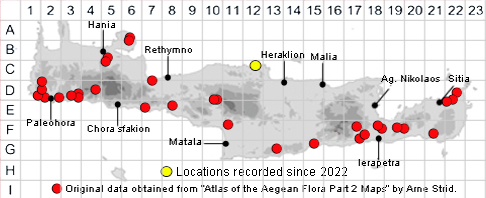
SPECIES DESCRIPTION
ALKANNA SIEBERI
Family and Genus:- See- BORAGINACEAE
Common Name:- None
Homotypic Synonyms:- None
Meaning:- Alkanna (L) From the Arabic, al-henna for Lawsonia inermis, the source
of henna.
Sieberi (L) For the botanist Franz Wilhelm Sieber (1785-1844).
General description:- A short perennial plant with short bristly hairs.
Stem:-
1) 10-30 cm, erect. branched from the base.
Leaves:-
1) With a mixture of tubercle-based setae and short eglandular hairs.
2) Basal, up to 4 cm, oblanceolate, subobtuse.
3) Cauline, shorter, lanceolate.
Flowers:-
1) Inflorescence, pedunculate, with tubular florets, twice as long as the calyx.
2) Corolla, pale pinkish, later turning blue, glabrous outside.
3) Bracts, as long as or slightly longer than the calyx. linear-lanceolate.
4) Calyx, 4-5 mm in flower, 6-7 mm in fruit.eglandular.
5) Limb, c. 4 mm. diam.
Fruit:-
1) Nutlets, c. 2 mm. diam. rugose or tuberculate.
Key features:-
1) Corolla-limb, c. 4 mm diam.
2) Tube, twice as long as calyx.
Habitat:- Stony pine woodland, sparse calcareous dry open shrubby vegetation,
maritime sands, abandoned cultivated land, sometimes on rocky hills up to 700 m.
(rarely 1300 m).
Distribution:- Endemic to Crete. Sparsely scattered mainly around southern
coastal areas.
Flowering time:- Mar-Apr.
Photos by:- Yannis Zacharakis and Steve Lenton
Status:-
Conservation status (for threatened species): Rare (R) according to IUCN 1997.
Protection status (for threatened species): Greek Presidential Decree 67/1981.
